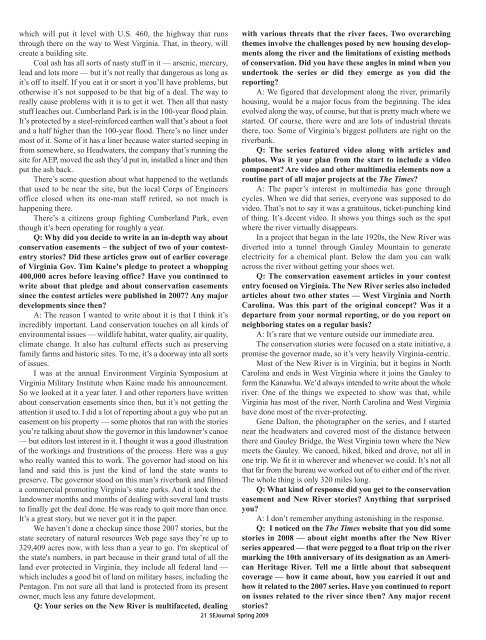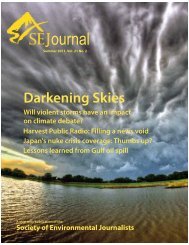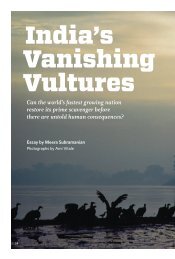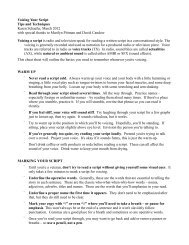PDF Download - Society of Environmental Journalists
PDF Download - Society of Environmental Journalists
PDF Download - Society of Environmental Journalists
Create successful ePaper yourself
Turn your PDF publications into a flip-book with our unique Google optimized e-Paper software.
which will put it level with U.S. 460, the highway that runsthrough there on the way to West Virginia. That, in theory, willcreate a building site.Coal ash has all sorts <strong>of</strong> nasty stuff in it — arsenic, mercury,lead and lots more — but it’s not really that dangerous as long asit’s <strong>of</strong>f to itself. If you eat it or snort it you’ll have problems, butotherwise it’s not supposed to be that big <strong>of</strong> a deal. The way toreally cause problems with it is to get it wet. Then all that nastystuff leaches out. Cumberland Park is in the 100-year flood plain.It’s protected by a steel-reinforced earthen wall that’s about a footand a half higher than the 100-year flood. There’s no liner undermost <strong>of</strong> it. Some <strong>of</strong> it has a liner because water started seeping infrom somewhere, so Headwaters, the company that’s running thesite for AEP, moved the ash they’d put in, installed a liner and thenput the ash back.There’s some question about what happened to the wetlandsthat used to be near the site, but the local Corps <strong>of</strong> Engineers<strong>of</strong>fice closed when its one-man staff retired, so not much ishappening there.There’s a citizens group fighting Cumberland Park, eventhough it’s been operating for roughly a year.Q: Why did you decide to write in an in-depth way aboutconservation easements – the subject <strong>of</strong> two <strong>of</strong> your contestentrystories? Did these articles grow out <strong>of</strong> earlier coverage<strong>of</strong> Virginia Gov. Tim Kaine's pledge to protect a whopping400,000 acres before leaving <strong>of</strong>fice? Have you continued towrite about that pledge and about conservation easementssince the contest articles were published in 2007? Any majordevelopments since then?A: The reason I wanted to write about it is that I think it’sincredibly important. Land conservation touches on all kinds <strong>of</strong>environmental issues — wildlife habitat, water quality, air quality,climate change. It also has cultural effects such as preservingfamily farms and historic sites. To me, it’s a doorway into all sorts<strong>of</strong> issues.I was at the annual Environment Virginia Symposium atVirginia Military Institute when Kaine made his announcement.So we looked at it a year later. I and other reporters have writtenabout conservation easements since then, but it’s not getting theattention it used to. I did a lot <strong>of</strong> reporting about a guy who put aneasement on his property — some photos that ran with the storiesyou’re talking about show the governor in this landowner’s canoe— but editors lost interest in it. I thought it was a good illustration<strong>of</strong> the workings and frustrations <strong>of</strong> the process. Here was a guywho really wanted this to work. The governor had stood on hisland and said this is just the kind <strong>of</strong> land the state wants topreserve. The governor stood on this man’s riverbank and filmeda commercial promoting Virginia’s state parks. And it took thelandowner months and months <strong>of</strong> dealing with several land truststo finally get the deal done. He was ready to quit more than once.It’s a great story, but we never got it in the paper.We haven’t done a checkup since those 2007 stories, but thestate secretary <strong>of</strong> natural resources Web page says they’re up to329,409 acres now, with less than a year to go. I'm skeptical <strong>of</strong>the state's numbers, in part because in their grand total <strong>of</strong> all theland ever protected in Virginia, they include all federal land —which includes a good bit <strong>of</strong> land on military bases, including thePentagon. I'm not sure all that land is protected from its presentowner, much less any future development.Q: Your series on the New River is multifaceted, dealing21 SEJournal Spring 2009with various threats that the river faces. Two overarchingthemes involve the challenges posed by new housing developmentsalong the river and the limitations <strong>of</strong> existing methods<strong>of</strong> conservation. Did you have these angles in mind when youundertook the series or did they emerge as you did thereporting?A: We figured that development along the river, primarilyhousing, would be a major focus from the beginning. The ideaevolved along the way, <strong>of</strong> course, but that is pretty much where westarted. Of course, there were and are lots <strong>of</strong> industrial threatsthere, too. Some <strong>of</strong> Virginia’s biggest polluters are right on theriverbank.Q: The series featured video along with articles andphotos. Was it your plan from the start to include a videocomponent? Are video and other multimedia elements now aroutine part <strong>of</strong> all major projects at the The Times?A: The paper’s interest in multimedia has gone throughcycles. When we did that series, everyone was supposed to dovideo. That’s not to say it was a gratuitous, ticket-punching kind<strong>of</strong> thing. It’s decent video. It shows you things such as the spotwhere the river virtually disappears.In a project that began in the late 1920s, the New River wasdiverted into a tunnel through Gauley Mountain to generateelectricity for a chemical plant. Below the dam you can walkacross the river without getting your shoes wet.Q: The conservation easement articles in your contestentry focused on Virginia. The New River series also includedarticles about two other states — West Virginia and NorthCarolina. Was this part <strong>of</strong> the original concept? Was it adeparture from your normal reporting, or do you report onneighboring states on a regular basis?A: It’s rare that we venture outside our immediate area.The conservation stories were focused on a state initiative, apromise the governor made, so it’s very heavily Virginia-centric.Most <strong>of</strong> the New River is in Virginia, but it begins in NorthCarolina and ends in West Virginia where it joins the Gauley t<strong>of</strong>orm the Kanawha. We’d always intended to write about the wholeriver. One <strong>of</strong> the things we expected to show was that, whileVirginia has most <strong>of</strong> the river, North Carolina and West Virginiahave done most <strong>of</strong> the river-protecting.Gene Dalton, the photographer on the series, and I startednear the headwaters and covered most <strong>of</strong> the distance betweenthere and Gauley Bridge, the West Virginia town where the Newmeets the Gauley. We canoed, hiked, biked and drove, not all inone trip. We fit it in wherever and whenever we could. It’s not allthat far from the bureau we worked out <strong>of</strong> to either end <strong>of</strong> the river.The whole thing is only 320 miles long.Q: What kind <strong>of</strong> response did you get to the conservationeasement and New River stories? Anything that surprisedyou?A: I don’t remember anything astonishing in the response.Q: I noticed on the The Times website that you did somestories in 2008 — about eight months after the New Riverseries appeared — that were pegged to a float trip on the rivermarking the 10th anniversary <strong>of</strong> its designation as an AmericanHeritage River. Tell me a little about that subsequentcoverage — how it came about, how you carried it out andhow it related to the 2007 series. Have you continued to reporton issues related to the river since then? Any major recentstories?












